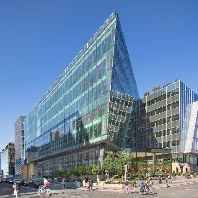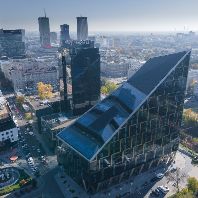Prime office yields in Berlin are currently very low at 3.85%1, although products in major German cities such as Frankfurt are still providing higher returns than those located in London or Paris. At the same time Romania and Hungary are seeing new capital flowing into their respective commercial real estate markets. This is a consequence of a significant yield spread between Western and Eastern Europe, where prime office yields, for example in Bucharest, are currently at 7.5%.
Favorable macro-economic conditions in CEE countries have also contributed to this shift in investor interest, something that the CEE Investment Report 2016: Mission to Outperform underlines. According to the World Bank Group, the Czech Republic, Hungary, Poland, Romania and Slovakia will remain among the fastest growing economies in the EU over the next few years. Moody’s forecasts state that these countries should also be resilient to international economic and local socio-political challenges for the near future. Poland and the Czech Republic, the most mature of the CEE markets, are still regional leaders in terms of commercial real estate transaction volumes with 40% and 18.5% market share respectively2. However, international investors have already identified new opportunities in the form of other CEE countries that have higher yields than Prague and Warsaw.
“Hungary and Romania are two markets that offer quality products with very attractive prime office yields in their capital cities: 6,75% in Budapest and 7.5% in Bucharest – almost twice as high as those in western European countries. It’s no wonder then that CEE locations are attracting an increasing number of global players who seek both profitability and diversification of their asset portfolio. In H1 2016 we observed new investors, such as Zeus Capital and KGAL entering the Budapest commercial real estate market, and we expect to see more newcomers in the near future,” says Adrian Karczewicz, Head of Divestments CEE at Skanska Commercial Development Europe.
Hungary attracts FDIs
According to JLL, the increasing pool of foreign capital targeting Budapest and the growing appetite of banks to finance deals is dramatically increasing liquidity3. Budapest’s real estate market fundamentals remain robust, with solid occupier demand, declining vacancy rates and a limited development pipeline. One of the main factors boosting the demand for modern office space is the business services sector, which is also the main driver of employment growth in Hungary. Favorable operating conditions has encouraged UNICEF to open its Global Shared Services Center in Budapest, attracted by a highly-quali?ed workforce, well-established infrastructure and a relatively low cost of doing business. In 2015, Hungarian GDP grew by 2.9%. The country’s government forecasts that GDP growth will remain above 3% between 2018 and 20204. This means Hungary will still be attracting major new FDIs, such as that of Daimler (Mercedes Benz) which is planning to build a car plant in Kecskemet for USD 660m.
Romania is growing fast
The Romanian economy offers another great investment opportunity. Since the ?nancial crisis, GDP growth in Romania has been driven by a gradual recovery of domestic demand and strong exports. With 3.8%, the country had one of 2015's highest growth rates in the European Union, behind Sweden, the Czech Republic and Luxemburg5, while in Q2 2016 Romania recorded the highest growth (+5.9%) among Member States compared with the same quarter of the previous year.
“Romania owed its rapid growth in 2015 mainly to manufacturing, information and communication technologies (ICT) and trade. It’s not a coincidence that for every six Euros of GDP growth, one Euro was provided by ICT. In 2016, ICT continues to be one of the main drivers of growth. The rapid development of the industry is also due to the fact that roughly half of the ICT and BPO business was focused outside Bucharest, thus taking advantage of the talent pool available outside of the capital city. Universitary hubs such as Cluj-Napoca, Iasi, Sibiu, Brasov or Timisoara are well-known for software development capabilities and skills required for BPO/SSC investment projects. For 2016, Leoni, Allianz and Bombardier announced new investments, and expansions of existing centers of excellence for outsourcing services. The recorded boost in 2015 for the Romanian retail market was mainly due to an increase in salary (8.4% y-o-y in real terms) and the cutting of VAT on food products from 24% to 9%. Although Romania still has a lot of work to do in order to close the salaries gap with other CEE countries, we consider latest changes as strong indicators of further growth in the retail real estate sector,” says Alexandru Mitroi, Counsellor at Invest Romania.
Romanian property investment volume in the first half of 2016 is estimated at €340 million, 80% higher than the number registered in the corresponding period last year (€187 million). Bucharest accounted for close to 48% of the total investment volume, with retail, office and industrial transactions in the city leading the way with 45%, 38% and 17% respectively7. Cushman & Wakefield reports that the Romanian Sibiu Shopping City retail park in Sibiu, was acquired by Nepi from the Argo group for EUR 100 million and was the region's largest single property transaction in Q2 20168. Romania also witnessed new players entering the market, like Logicor, and Blackstone’s European industrial division which acquired Immofinanz portfolio.
CEE locations offer exceptionally attractive investment opportunities, especially for those who are quick to make decisions regarding investing in the CEE's commercial real estate market.
More facts about Romania, Hungary and other CEE markets are available in the CEE Investment Report 2016: Mission to Outperform. Click here to download.















